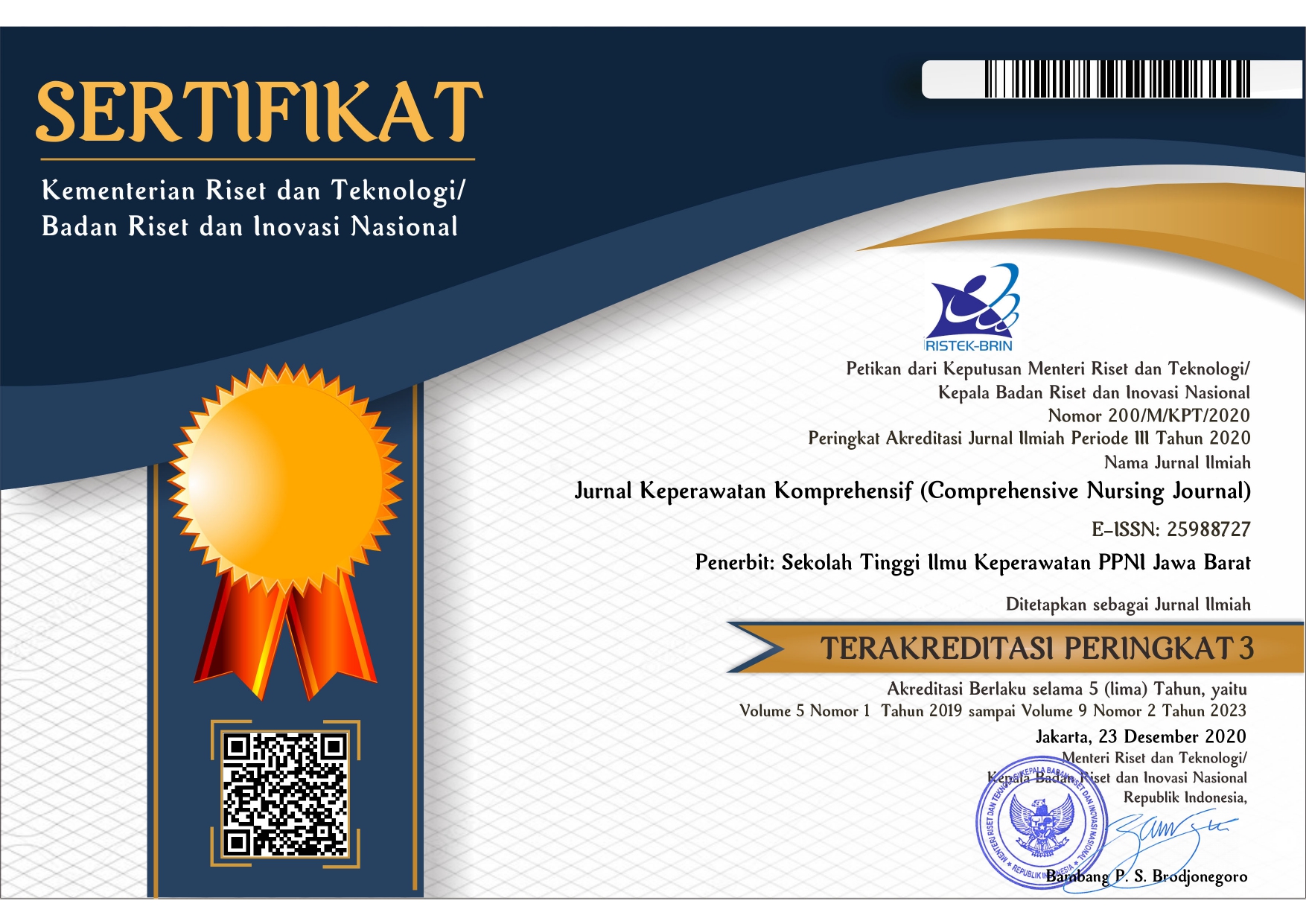Effect of Mirror Therapy Intervention on Motor Impairment Improvements in Elderly
DOI:
https://doi.org/10.33755/jkk.v9i4.619Abstract
Aims: The slowness in the elderly activities is caused by a decrease in function of the musculoskeletal system, characterized by a decrease or increase in fat free mass which can cause a decrease in muscle mass, resulting in motor disorders. It is believed that providing range of motion exercises such as mirror therapy can stimulate the nerves in the motor cortex, thus providing signals to the brain to stimulate movement.
Objective: This research is to identify the effect of mirror therapy on motor impairment in the elderly.
Method: This type of research used quasi-experiment with two group pretest-posttest design approach and analysis method used Generalized Linear Model (GLM). The sample was 84 respondents, consisting of 42 intervention group samples and 42 control group samples. Sampling techniques were generally used as samples according to inclusion and exclusion criteria. The intervention was given for 4 weeks and assessed every week.
Results: There was an effect of mirror therapy intervention on improving motor impairment in the elderly (p-value = 0.000). Conclusion: mirror therapy is a non-pharmacological therapy that can be used to improve motor impairment in the elderly.
References
Studer M. Making Balance Automatic Again: Using Dual Tasking as an Intervention in Balance Rehabilitation for Older Adults. SM Gerontology and Geriatric Research. 2018;2(1):1–11.
Maulana MI, Purnomo S. Pengaruh Pemberian Mirror Therapy terhadap Fungsi Motorik pada Pasien Stroke yang Menderita Hemiparesis Ekstremitas Bawah: Literatur Review. Borneo Studies and Research. 2022;3(3):2664–76.
Sagala NJ, Sofyani S, Supriatmo S. Association between sleep quality and obesity in adolescents. Paediatr Indones. 2017;57(1):41–6.
Elizabeth B, Wanda D, Apriyanti E. The correlation between sleep quality and the prevalence of obesity in school-age children. J Public Health Res. 2021;10(1_suppl):jphr-2021.
Montero-Odasso MM, Kamkar N, Pieruccini-Faria F, Osman A, Sarquis-Adamson Y, Close J, et al. Evaluation of Clinical Practice Guidelines on Fall Prevention and Management for Older Adults: A Systematic Review. JAMA Network Open. 2021;4(12):1–15.
Jan S, Arsh A, Darain H, Gul S. A randomized control trial comparing the effects of motor relearning programme and mirror therapy for improving upper limb motor functions in stroke patients. JPMA The Journal of the Pakistan Medical Association. 2019;69(9):1242–5.
Istianah I, Arsana IG, Hapipah H, Arifin Z. Efektifitas Mirror Therapy terhadap Kekuatan Otot dan Status Fungsional Pasien Stroke Non Hemoragik. The Indonesian Journal of Health Science. 2021;12(2):158–68.
Pratiwi A. Prosedur Mirror Therapy Pada Pasien Stroke. Seminar Workshop Nasional Keperawatan. 2017;3(1):157–63.
Machyono M, Tammasse J, Kaelan C, Muis A, Ganda IJ. Efektivitas Terapi Cermin Terhadap Perbaikan Motorik Lengan Pasien Stroke Iskemik Akut. Majalah Kedokteran Neurosains Perhimpunan Dokter Spesialis Saraf Indonesia. 2018;35(2):93–7.
Nurseptiani D, Tresnowati I, Maghfiroh A, Kejadian A, Muskuloskeletal G, Lanjut P, et al. Analysis Of The Occurrence Of Muskuloskeletal Disorder In The Elderly In Kedungwuni. 2022;410.
Rianti EDD, Soekanto A, Lystyawati F. HUBUNGAN ANGKA KEJADIAN KELUHAN MUSKULOSKELETAL DENGAN USIA Di WILAYAH KERJA PUKSESMAS DUKUH KUPANG RW V SURABAYA. BIOSAPPHIRE: Jurnal Biologi dan Diversitas. 2023;2(1):36–43.
Miclaus RS, Roman N, Henter R, Caloian S. Lower extremity rehabilitation in patients with post-stroke sequelae through virtual reality associated with mirror therapy. International Journal of Environmental Research and Public Health. 2021;18(5):1–14.
Nursalam N, Kurnia ID, Aridamayanti BG. Mirror therapy using cylindrical grip muscle strength and extremity range of motion. International Journal of Innovation, Creativity and Change. 2020;13(6):263–75.
Cuenca‐Martínez F, Reina‐Varona Á, Castillo‐García J, La Touche R, Angulo‐Díaz‐Parreño S, Suso‐Martí L. Pain relief by movement representation strategies: An umbrella and mapping review with meta‐meta‐analysis of motor imagery, action observation and mirror therapy. European journal of pain. 2022;26(2):284–309.
May HI, Özdolap Å, Mengi A, Sarikaya S. The effect of mirror therapy on lower extremity motor function and ambulation in post-stroke patients: A prospective, randomized-controlled study. Turkish Journal of Physical Medicine and Rehabilitation. 2020;66(2):154–60.
May Hİ, Özdolap Ş, Mengi A, Sarıkaya S. The effect of mirror therapy on lower extremity motor function and ambulation in post-stroke patients: A prospective, randomized-controlled study. Turk J Phys Med Rehabil. 2020;66(2):154.








